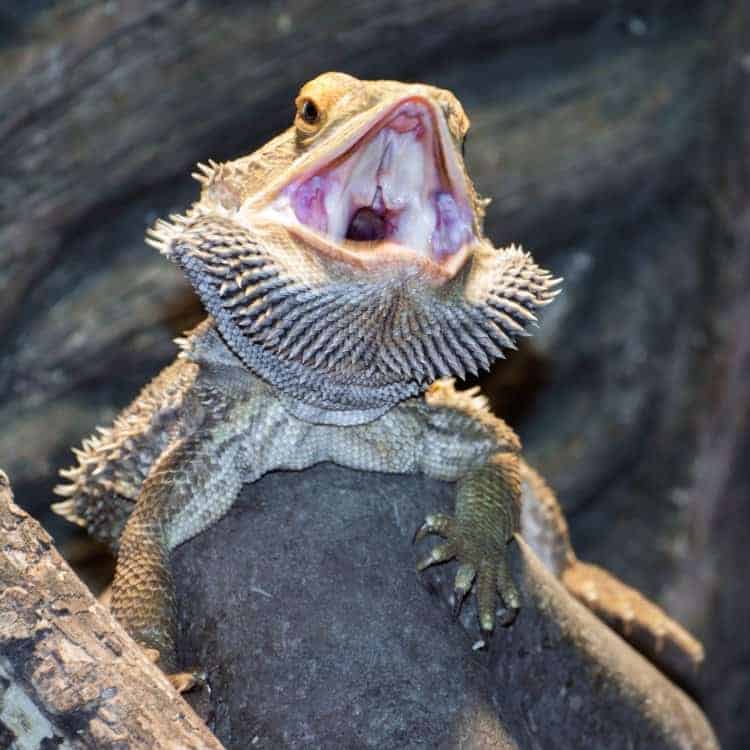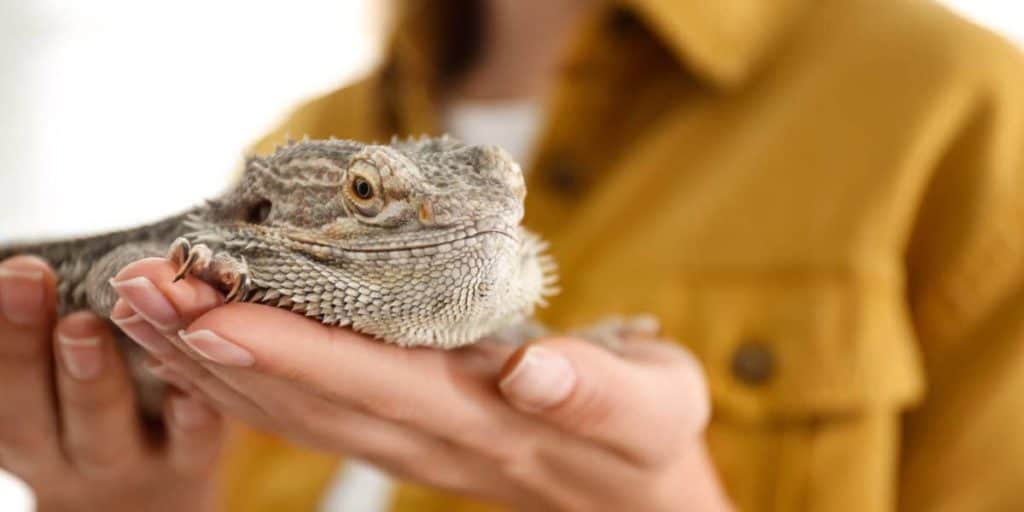Bearded dragons (Pogona) are lizards native to Australia that have gained popularity as pets due to their gentle nature, distinctive appearance, and manageable care requirements. These reptiles are characterised by spiky scales around their throat, which can be expanded to form a beard-like structure, giving them their common name. Their friendly disposition and relatively straightforward care needs make them suitable pets for reptile enthusiasts of varying experience levels.
As diurnal animals, bearded dragons are active during daylight hours and rest at night. In their natural habitats, which include deserts, woodlands, and scrublands, they exhibit omnivorous feeding habits, consuming insects, vegetation, and occasionally small mammals. In captivity, their diet should consist of live insects such as crickets and mealworms, complemented by a variety of leafy greens and vegetables.
Proper environmental conditions, including appropriate lighting and heating, are crucial for maintaining their health and well-being. Bearded dragons possess unique behaviours and communication methods that make them intriguing subjects for observation and care. Their adaptability to captive environments, combined with their distinctive traits, contributes to their appeal as pets in the reptile-keeping community.
Key Takeaways
- Bearded dragons are popular reptile pets known for their docile nature and unique appearance.
- Understanding bearded dragon behaviour involves observing their body language, vocalisations, and social interactions.
- Bearded dragons communicate through various body movements such as head bobbing, arm waving, and puffing up their beard.
- Vocalisations and sounds of bearded dragons include hissing, chirping, and even a form of “arm waving” to communicate.
- Social interactions and hierarchies in bearded dragons are important for understanding their behaviour and maintaining a healthy environment for them.
Understanding Bearded Dragon Behaviour
Thermoregulation through Basking
One common behaviour is basking, where they will spend time under a heat lamp or in direct sunlight to regulate their body temperature. This behavior is essential for their health, as it helps them digest food and absorb essential nutrients.
Communication and Social Behaviour
Another behaviour is head bobbing, which is often seen in male bearded dragons as a form of communication or display of dominance. They may also exhibit arm waving, which is a submissive behaviour often seen in response to a perceived threat or during social interactions.
Sleeping Habits and Brumation
Bearded dragons are also known for their unique sleeping habits. They may brumate, which is a period of dormancy similar to hibernation, during the winter months. This behaviour is natural for bearded dragons and should not be cause for concern as long as they are healthy and have been properly cared for. Understanding these behaviours can help pet owners provide the best possible care for their bearded dragons and ensure they are happy and healthy.
Communication in Bearded Dragons

Bearded dragons communicate with each other and with their human caretakers through a variety of visual cues and body language. One common form of communication is through color changes. Bearded dragons can change the color of their beard and body to indicate their mood or level of stress.
For example, a darkened beard may indicate aggression or stress, while a lighter color may indicate relaxation or contentment. They may also puff out their beard as a form of intimidation or defense. Another form of communication is through body posture.
Bearded dragons may flatten their bodies to appear larger and more intimidating, especially during territorial disputes or when interacting with potential mates. They may also raise their bodies onto their front legs to appear taller and more dominant. Understanding these visual cues can help pet owners interpret their bearded dragon’s mood and respond accordingly to ensure their well-being.
Body Language of Bearded Dragons
Bearded dragons have a wide range of body language cues that can provide insight into their mood and intentions. One common behaviour is arm waving, where they will slowly wave one of their front legs in a circular motion. This behaviour is often seen in response to a perceived threat or during social interactions with other bearded dragons.
It is a submissive gesture that can help diffuse potential conflicts and establish social hierarchies. Another important body language cue is head bobbing, which is often seen in male bearded dragons as a form of communication or display of dominance. This behaviour involves rapidly bobbing their head up and down, often accompanied by the inflation of their beard.
It can be used to assert dominance over other males or to court potential mates. Understanding these body language cues can help pet owners better understand and interpret their bearded dragon’s behaviour, leading to improved care and handling.
Vocalisations and Sounds of Bearded Dragons
While bearded dragons are not known for being particularly vocal creatures, they do produce a variety of sounds that can provide insight into their mood and intentions. One common sound is a hiss, which is often produced when they feel threatened or stressed. This sound is meant to intimidate potential predators or threats and can be accompanied by other defensive behaviours such as puffing out their beard or flattening their body.
Bearded dragons may also produce a variety of other sounds, including chirps, clicks, and even squeaks. These sounds are often used during social interactions with other bearded dragons and can vary in intensity and frequency depending on the situation. While these vocalisations may not be as prominent as those of other reptiles, they are an important aspect of bearded dragon communication that can provide valuable insight into their behaviour and well-being.
Social Interactions and Hierarchies in Bearded Dragons

Social Interactions Among Males
Male bearded dragons engage in various behaviours to assert dominance over other males or to court potential mates. These behaviours include head bobbing and arm waving, which play a crucial role in establishing social hierarchies within a group of bearded dragons. By understanding these behaviours, pet owners can help prevent conflicts or aggression among their pets.
Females and Mating Season
Female bearded dragons also engage in social interactions, especially during mating season. They display receptive behaviours such as head bobbing or body positioning to indicate their willingness to mate with a male. Recognising these behaviours is essential for pet owners to provide the best possible care for their female bearded dragons.
Importance of Social Interactions for Pet Owners
Understanding the social interactions of bearded dragons is vital for pet owners to provide the best possible care for their pets. By recognising and accommodating these natural behaviours, pet owners can ensure their bearded dragons are able to engage in natural behaviours that contribute to their overall well-being.
Conclusion and Tips for Understanding Bearded Dragon Behaviour
In conclusion, bearded dragons are fascinating creatures with unique behaviours and communication methods that make them a joy to observe and care for. By understanding their body language, vocalisations, and social interactions, pet owners can provide the best possible care for their bearded dragons and ensure they are happy and healthy. It is important to provide a suitable habitat with proper lighting and heating, as well as a balanced diet of live insects and vegetables.
Additionally, regular handling and interaction with human caretakers can help socialise bearded dragons and provide mental stimulation. When observing bearded dragon behaviour, it is important to consider their natural instincts and behaviours in the wild. This can help pet owners better understand and interpret their actions in a captive environment.
By providing a suitable habitat and understanding their unique behaviours, pet owners can ensure that their bearded dragons thrive in captivity and lead happy, healthy lives.
If you’re interested in learning more about exotic pets, you might want to check out this article on poison dart frogs as pets. Just like bearded dragons, poison dart frogs have their own unique behaviours and communication methods that can be fascinating to observe and understand. Whether you’re a seasoned reptile owner or just starting out, it’s always beneficial to expand your knowledge of different exotic pets and their behaviours.
FAQs
What are some common behaviours of bearded dragons?
Some common behaviours of bearded dragons include basking under a heat lamp, head bobbing, arm waving, tail wagging, and glass surfing. They may also puff up their beard and change color to communicate their mood.
How do bearded dragons communicate with each other?
Bearded dragons communicate with each other through a variety of visual signals and body language. This can include head bobbing, arm waving, and changing color. They may also use vocalisations and scent marking to communicate.
What does it mean when a bearded dragon head bobs?
Head bobbing in bearded dragons can be a sign of dominance, aggression, or courtship. It is important to observe other body language and context to understand the meaning behind the head bobbing behaviour.
Why do bearded dragons wave their arms?
Bearded dragons may wave their arms as a sign of submission or to communicate with other bearded dragons. This behaviour is often seen when they are trying to establish social hierarchy or during courtship displays.
What is glass surfing in bearded dragons?
Glass surfing is a behaviour in which a bearded dragon repeatedly runs or scratches against the walls of its enclosure. This behaviour can be a sign of stress, boredom, or a desire for more space. It is important to address the underlying cause of glass surfing to ensure the well-being of the bearded dragon.




